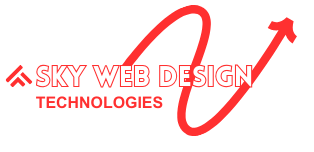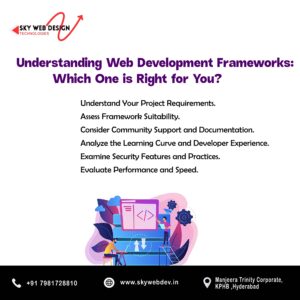- + 91 7981728810
- info@skywebdev.in
- KPHB,Hyderabad

Understanding Web Development Frameworks: Which One is Right for You?
Web development frameworks have become essential tools for developers, providing a structured and efficient way to build websites and web applications. With a myriad of options available, choosing the right framework can be daunting, especially for businesses or developers just starting out. This guide aims to break down the basics of web development frameworks, explore popular options, and provide insights into how to choose the one that best fits your project needs.

What is a Web Development Framework?
A web development framework is a collection of pre-written code that developers can use to build web applications. These frameworks provide a foundation of common functionalities, which developers can then customize and expand upon. By using a framework, developers can streamline the development process, reduce errors, and focus on the unique aspects of their application.
Frameworks are designed to handle a variety of tasks, including:
Routing: Managing how web requests are handled.
Database interaction: Simplifying the process of interacting with databases.
Session management: Handling user sessions and data storage.
Security: Offering built-in tools to protect against common security threats.
Frameworks can be broadly categorized into front-end and back-end frameworks:
Front-End Frameworks: These are used for designing the user interface and user experience (UI/UX). They help in managing the layout, styling, and behavior of the elements on the page.
Back-End Frameworks: These handle the server-side logic, database interactions, authentication, and data management.
Popular Web Development Frameworks
There are numerous web development frameworks available, each with its own strengths and weaknesses. Below are some of the most widely used frameworks in both the front-end and back-end categories.
- Front-End Frameworks
React
Overview: Developed by Facebook, React is a JavaScript library that focuses on building user interfaces. It allows developers to create reusable UI components, making code more modular and maintainable.
Key Features:
Virtual DOM for efficient rendering.
Component-based architecture.
Strong community support and extensive libraries.
When to Use: Ideal for building complex, interactive UIs, particularly for single-page applications (SPAs).
Angular
Overview: Developed by Google, Angular is a comprehensive front-end framework that offers a complete solution for building dynamic web applications.
Key Features:
Two-way data binding for seamless synchronization between the model and view.
Dependency injection to manage and inject services.
Built-in tools for testing and optimization.
When to Use: Best suited for large-scale enterprise applications where a comprehensive solution is needed.
Vue.js
Overview: Vue.js is a progressive JavaScript framework that is easy to integrate into existing projects and can scale to build complex applications.
Key Features:
Incrementally adoptable architecture.
Flexible and easy to integrate with other libraries.
Reactive data binding and components.
When to Use: Ideal for developers looking for simplicity and flexibility, especially for smaller projects or when integrating with existing applications.
- Back-End Frameworks
Django
Overview: Django is a high-level Python web framework that encourages rapid development and clean, pragmatic design.
Key Features:
Built-in admin interface for managing site content.
ORM (Object-Relational Mapping) for database operations.
Security features to protect against common vulnerabilities.
When to Use: Suitable for projects that require rapid development, such as content management systems (CMS), e-commerce sites, and social networking platforms.
Ruby on Rails
Overview: Rails is a server-side web application framework written in Ruby. It follows the convention over configuration (CoC) and don’t repeat yourself (DRY) principles.
Key Features:
Scaffolding to quickly generate boilerplate code.
Active Record for database interactions.
Extensive community and plugins (gems) for additional functionalities.
When to Use: Ideal for startups and projects that need to get off the ground quickly, particularly those involving social media, e-commerce, or SaaS platforms.
Express.js
Overview: Express.js is a minimal and flexible Node.js web application framework that provides a robust set of features for building web and mobile applications.
Key Features:
Middleware support for handling requests and responses.
Easy integration with databases like MongoDB and MySQL.
Lightweight and unopinionated, giving developers control over the architecture.
When to Use: Best suited for building RESTful APIs and single-page applications with a Node.js backend.
How to Choose the Right Framework
Selecting the right web development framework depends on various factors, including the project requirements, developer expertise, and long-term goals. Here are some key considerations:
- Project Requirements
Complexity and Scale: For large-scale applications, frameworks like Angular or Django offer comprehensive solutions, while for simpler projects, Vue.js or Express.js might be more appropriate.
Performance Needs: If your application demands high performance and scalability, consider frameworks like React (front-end) and Node.js with Express (back-end).
- Developer Expertise
Language Familiarity: Choose a framework that aligns with your team’s expertise. For example, if your team is well-versed in Python, Django would be a natural choice.
Learning Curve: Some frameworks, like Angular, have a steep learning curve, while others, like Vue.js, are easier to pick up. Consider the time available for learning and development.
- Community and Ecosystem
Support and Documentation: A framework with a strong community and extensive documentation can greatly ease the development process. React and Django, for example, have vibrant communities and a wealth of learning resources.
Ecosystem and Plugins: The availability of plugins and third-party tools can extend the functionality of a framework, speeding up development and reducing costs.
- Long-Term Maintenance
Sustainability: Consider whether the framework is actively maintained and likely to be supported in the long term. Established frameworks like Django and Rails have proven longevity.
Upgradability: Look for frameworks that offer easy upgrades and backward compatibility to avoid issues when maintaining and scaling the application.
- Security
Built-In Security Features: Frameworks like Django and Rails offer robust security features out of the box, which is crucial for applications handling sensitive data.
Community Practices: A framework’s community often develops best practices for securing applications, which can be a valuable resource.
- Cost Considerations
Development Costs: Some frameworks may require more development time and resources, depending on the complexity of the project. Weigh these costs against the benefits of using a particular framework.
Hosting and Deployment Costs: Consider the hosting environment and any associated costs. For example, Node.js applications might require different hosting solutions compared to traditional PHP or Ruby applications.
Popular Use Cases and Examples
E-Commerce Websites
Frameworks Used: Django, Ruby on Rails, React.
Why These Frameworks? These frameworks offer robust support for building scalable, secure, and feature-rich e-commerce platforms. Django’s built-in admin interface and Rails’ Active Record make it easy to manage products, orders, and customers, while React provides a dynamic and responsive front-end.
Content Management Systems (CMS)
Frameworks Used: Django, Express.js, Angular.
Why These Frameworks? Django’s admin interface and ORM are perfect for building custom CMS platforms, while Express.js and Angular can be used to build headless CMS solutions that offer flexibility and scalability.
Social Media Platforms
Frameworks Used: Ruby on Rails, React, Node.js.
Why These Frameworks? Ruby on Rails provides the scaffolding and quick setup needed to launch a social media platform quickly. React and Node.js are often used to build interactive and real-time features like chat, notifications, and live updates.
Single Page Applications (SPAs)
Frameworks Used: React, Angular, Vue.js.
Why These Frameworks? These front-end frameworks are designed to handle dynamic content and user interactions efficiently, making them ideal for SPAs that require a seamless user experience without page reloads.
The Future of Web Development Frameworks
As web technologies evolve, so do the frameworks that support them. Some trends to watch for in the coming years include:
Serverless Frameworks: The rise of serverless architectures is leading to new frameworks that simplify the development of scalable, event-driven applications.
JAMstack (JavaScript, APIs, Markup): JAMstack is gaining popularity as a modern web development architecture, focusing on decoupling the front-end from the back-end, which can lead to faster, more secure applications.
Low-Code/No-Code Frameworks: These frameworks aim to make web development more accessible by reducing the need for traditional coding skills, allowing more people to build and deploy web applications.
Conclusion
Choosing the right web development framework is a critical decision that can impact the success of your project. By understanding the strengths and weaknesses of different frameworks, considering your project’s specific needs, and aligning with your team’s expertise, you can make an informed choice that will set the foundation for a successful web application. Whether you’re building a small personal blog or a large-scale enterprise platform, there’s a framework out there that’s perfect for your needs.
Address: 15th floor, Manjeera Trinity Corporate, KPHB, Hyderabad 500072
Mobile No.:+91 7981728810
Email id: info@skywebdev.in
Website: https://skywebdev.in/
Visit Link
- Privacy
- Terms & Conditions
Quick Links
Contact
+91 7981728810
info@skywebdev.in
Address
15th floor, Manjeera Trinity Corporate, JNTU - Hitech City Road, KPHB, Hyderabad-500072
Copyright © 2024 Sky Web Design Technologies. All Rights Reserved.